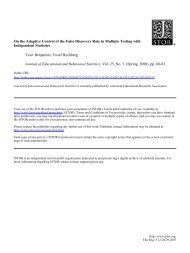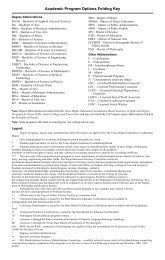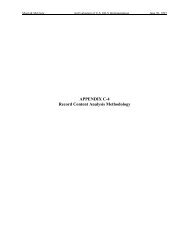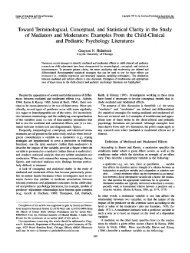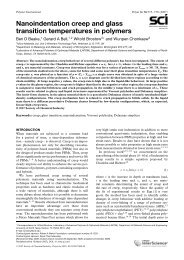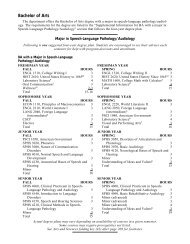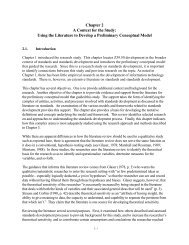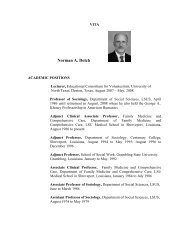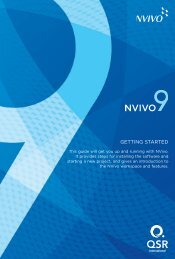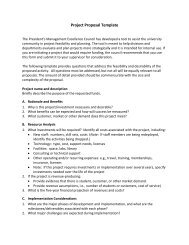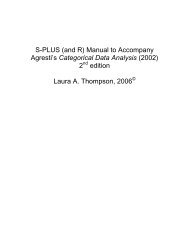APPENDIX D Sample of Analysis in Developing Historical ...
APPENDIX D Sample of Analysis in Developing Historical ...
APPENDIX D Sample of Analysis in Developing Historical ...
You also want an ePaper? Increase the reach of your titles
YUMPU automatically turns print PDFs into web optimized ePapers that Google loves.
<strong>APPENDIX</strong> D<br />
<strong>Sample</strong> <strong>of</strong> <strong>Analysis</strong> <strong>in</strong> Develop<strong>in</strong>g <strong>Historical</strong> Reconstruction<br />
This appendix illustrates the develop<strong>in</strong>g <strong>of</strong> the historical reconstruction <strong>of</strong> Z39.50 development reported <strong>in</strong> Chapter<br />
4. The first selection shows the prelim<strong>in</strong>ary chronology for 1980, the first full year <strong>of</strong> Subcommittee D’s standards<br />
work. The dates <strong>in</strong> the entries l<strong>in</strong>k directly to the source document (<strong>in</strong> the FolioView system).<br />
Illustration <strong>of</strong> Chronology Development <strong>in</strong> FolioViews<br />
1980<br />
January 7, 1980<br />
DCH sends an announcement for the next meet<strong>in</strong>g <strong>of</strong> SC D to be held at OCLC on January 29, 1980.<br />
Tentative agenda <strong>in</strong>cludes: review <strong>of</strong> action items; discussion on us<strong>in</strong>g actual implementations and real experiences<br />
to develop standard protocols.<br />
January 15, 1980<br />
DCH submits a "Subcommittee Status Report" that describes both current status and next steps. This is an<br />
adm<strong>in</strong>istrative tool for SCs to communicate with the coord<strong>in</strong>ator <strong>of</strong> the committee (<strong>in</strong> this case it is Sally H.<br />
McCallum). The topic <strong>of</strong> this report is the October 19, 1979 meet<strong>in</strong>g. [See also the m<strong>in</strong>utes and report from the<br />
meet<strong>in</strong>g.]<br />
January 29, 1980<br />
Second meet<strong>in</strong>g <strong>of</strong> the SC D.<br />
March 25, 1980<br />
A "Subcommittee Status Report" submitted to SHM. Topic <strong>of</strong> the report is the January 29, 1980 meet<strong>in</strong>g. [See also<br />
the m<strong>in</strong>utes and report from the meet<strong>in</strong>g.]<br />
April 15, 1980<br />
DCH announces the next meet<strong>in</strong>g <strong>of</strong> SC D for April 29, 1980 <strong>in</strong> Boston.<br />
April 29, 1980<br />
Third meet<strong>in</strong>g <strong>of</strong> SC D.<br />
June 26, 1980<br />
Subcommittee Status Report the topic <strong>of</strong> which is the April 29, 1980 meet<strong>in</strong>g. [See m<strong>in</strong>utes and report <strong>of</strong> meet<strong>in</strong>g<br />
below.]<br />
July 3, 1980<br />
Letter from Wood to Warren Haas, CLR, July 3, 1980:<br />
Request<strong>in</strong>g CLR to consider fund<strong>in</strong>g the work <strong>of</strong> a contractor who would work with Subcommittee D to draft "a set<br />
<strong>of</strong> applications protocols (e.g., search and retrieval, record distribution, <strong>in</strong>terlibrary loan), a set <strong>of</strong> guidel<strong>in</strong>es for<br />
creat<strong>in</strong>g other applications protocols, a description <strong>of</strong> how the applications protocols fit with other "lower level"<br />
protocols as def<strong>in</strong>ed <strong>in</strong> the ISO ANSI Reference Model for Open Systems Interconnection, and, if with<strong>in</strong> the scope<br />
<strong>of</strong> the contract, a recommendation on how the protocols should be tested, ref<strong>in</strong>ed, and implemented on systems."<br />
[Note from April 25 visit to Archive -- this makes more sense regard<strong>in</strong>g CLR support for specific <strong>in</strong>itiatives that tie<br />
<strong>in</strong>to the BSDP]<br />
Recognition by Wood <strong>of</strong> the need to move more quickly on this, and that there is a need for full-time attention on<br />
this which the current subcommittee members can't provide.<br />
D–1
Also, this is tied <strong>in</strong>to CLR support <strong>of</strong> the RLG/WLN/LC project and the national authority file service effort.<br />
"Development <strong>of</strong> protocols requires almost a full time commitment from an <strong>in</strong>dividual or <strong>in</strong>dividuals. Developers<br />
must review the development <strong>of</strong> other protocols and current standards activities with<strong>in</strong> the computer <strong>in</strong>dustry <strong>in</strong><br />
order to create "applications protocols" that fit with<strong>in</strong> the newly emerg<strong>in</strong>g layers <strong>of</strong> protocols....The developers must<br />
also be knowledgeable <strong>in</strong> library and <strong>in</strong>formation science applications <strong>in</strong> order to create mean<strong>in</strong>gful and useful<br />
protocols to exchange messages between systems."<br />
Wood also suggests that both RLG and WLN will be <strong>in</strong>vited to participate on SC D because <strong>of</strong> their participation on<br />
the WLN/RLG/LC L<strong>in</strong>ked Authority Systems Project.<br />
Suggests a contract amount <strong>of</strong> $25,000 - $30,000 for six man-months over a calendar year.<br />
July 15, 1980<br />
Letter from Hartmann to Wood, July 15, 1980:<br />
Suggests that Wayne Davison (RLG) and Tom Brown (WLN) be <strong>in</strong>vited to participate on SC D beg<strong>in</strong>n<strong>in</strong>g with the<br />
July 29, 1980 meet<strong>in</strong>g. Made it clear that these organizations will have to support their members participation at the<br />
meet<strong>in</strong>gs.<br />
July 15, 1980<br />
Letter form Mary Agnes Thompson (CLR) to Wood, July 15, 1980:<br />
Acknowledges Wood's letter to CLR and states that CLR is review<strong>in</strong>g the proposal for fund<strong>in</strong>g the development <strong>of</strong><br />
an application level protocol.<br />
July 28, 1980<br />
Letter from Farmer to Hartmann, July 28, 1980:<br />
Indicates that he will not be able to participate on SC D at least for the rest <strong>of</strong> 1980. Wants to be kept <strong>in</strong>formed <strong>of</strong><br />
developments. His current workload prohibits him from do<strong>in</strong>g any work on the ANSI Z39 network protocol.<br />
July 28, 1980<br />
Hartmann, Letter to Robert Payne, Director, WLN, <strong>in</strong>vit<strong>in</strong>g WLN to appo<strong>in</strong>t a representative to SC D; recommends<br />
that Tom Brown be the rep.<br />
Hartmann, Letter to Edward Shaw, President, RLG, <strong>in</strong>vit<strong>in</strong>g RLG to appo<strong>in</strong>t a representative to SC D; recommends<br />
that Wayne Davison be the rep.<br />
August 12, 1980<br />
Fourth meet<strong>in</strong>g <strong>of</strong> SC D.<br />
August 18, 1980<br />
Hartmann, Letter to T<strong>in</strong>a Kass, Director, Library Systems and Services, RLG, acknowledg<strong>in</strong>g the appo<strong>in</strong>tment <strong>of</strong><br />
Wayne Davison as rep to SC D<br />
Hartmann, Letter to Wayne Davison, RLG, acknowledg<strong>in</strong>g his appo<strong>in</strong>tment has been cleared by RLG and <strong>in</strong>vit<strong>in</strong>g<br />
him to serve on SC D<br />
September 5, 1980<br />
Memo from C. Lee Jones (Program <strong>of</strong>ficer, CLR) to Avram, Wood, Ray DeBuse (WLN), and T<strong>in</strong>a Kass (RLG)<br />
regard<strong>in</strong>g the development <strong>of</strong> Application Level Protocol, September 5, 1980:<br />
Indicates CLR's will<strong>in</strong>gness to provide fund<strong>in</strong>g; sees this as three groups each hav<strong>in</strong>g a dist<strong>in</strong>ct but vital role:<br />
WLN/RLG/LC LASP group will:<br />
• Prepare a requirements statement for an Application Level Protocol to <strong>in</strong>clude an <strong>in</strong>dication <strong>of</strong> the tim<strong>in</strong>g<br />
required by LASP. This document will also serve as a work statement for the consultant who will do the work.<br />
D–2
The work statement (requirements) will be completed as soon as possible, but <strong>in</strong> no case later than October 31,<br />
1980.<br />
• Identify an appropriate consultant for the task. The sooner this can be done the sooner CLR can beg<strong>in</strong><br />
negotiations. I hope a West Coast consultant can be identified <strong>in</strong> order to m<strong>in</strong>imize travel costs. To be<br />
completed by October 14, 1980.<br />
• Assign someone <strong>in</strong> the LASP group the day to day management responsibility for the consultant's work.<br />
Identified by November 1, 1980.<br />
ANSI, Subcommittee Z39 will:<br />
• Review, comment and concur on requirements (work statement) generated by LASP group. This must be done<br />
promptly <strong>in</strong> order not to <strong>in</strong>hibit LASP progress,<br />
• Monitor and provide comments on the consultant's progress. it is highly likely that committee members would<br />
be consulted dur<strong>in</strong>g the work period.<br />
• F<strong>in</strong>ally, to receive, review and move to standard status the document prepared by the consultant.<br />
CLR will:<br />
• Concur with work statement and consultant choice.<br />
• Negotiate with consultant to do the work, shar<strong>in</strong>g management with the WLN/RLG/LC LASP group.<br />
• Receive the consultant's report and forward it to Z39<br />
• Provide funds for the consultant and his/her expenses.<br />
"We have all agreed that Henriette Avram will forward to appropriate standards groups <strong>in</strong> Great Brita<strong>in</strong>, Canada and<br />
Australia various work<strong>in</strong>g documents and the f<strong>in</strong>al report <strong>of</strong> the consultant. This should help move the standards<br />
process along <strong>in</strong> this these countries and help provide an environment <strong>in</strong> which all four can take the same standard to<br />
ISO for adoption."<br />
September 12, 1980<br />
Payne, WLN, Letter to Wood, NISO, approv<strong>in</strong>g Tom Brown’s participation on SC d<br />
September 17, 1980<br />
Hartmann, Letter to Payne, WLN, acknowledg<strong>in</strong>g the appo<strong>in</strong>tment <strong>of</strong> Tom Brown as rep from WLN to SC D.<br />
[Note: <strong>in</strong> all these letters, Hartmann writes: “Ow<strong>in</strong>g to Subcommittee D’s limited fund<strong>in</strong>g, should WLN (or others)<br />
elect to jo<strong>in</strong> <strong>in</strong> this effort, and I hope you will, it will be necessary for WLN to support your representative’s travel<br />
to the Subcommittee D meet<strong>in</strong>gs.”<br />
September 26, 1980<br />
Letter from Wood to C. Lee Jones (CLR) September 26, 1980:<br />
Reports that the Z39 Executive Council at its Sept 24 meet<strong>in</strong>g "accepted with appreciation the CLR proposal for<br />
develop<strong>in</strong>g the application level protocol.<br />
October 29, 1980<br />
Letter from Wood to Avram, October 29, 1980:<br />
In response to a request for Z39 to send an observer to the NLC Task Group on Computer/Communications<br />
Protocols for Bibliographic Data Interchange.<br />
"Frankly, I do not believe Z39 will have the funds dur<strong>in</strong>g 1980 or 1981, but we might." [to send David Hartmann to<br />
these meet<strong>in</strong>gs.<br />
November 19, 1980<br />
Fifth meet<strong>in</strong>g <strong>of</strong> SC D.<br />
December 9, 1980<br />
Letter from Guy Sylvestre (National Librarian, NLC) to Wood, December 9, 1980:<br />
D–3
Acknowledg<strong>in</strong>g Hartmann's appo<strong>in</strong>tment as an observer from Z39 to his [Sylvestre's] Task Group on<br />
Computer/Communications Protocols for Bibliographic Data Interchange."<br />
December 11, 1980<br />
By the time <strong>of</strong> this memo which deals with expenses items for meet<strong>in</strong>gs, CLR and Z39 are engaged <strong>in</strong> some fund<strong>in</strong>g<br />
arrangement so that CLR is expected to pick up some <strong>of</strong> the expenses for a West Coast meet<strong>in</strong>g <strong>of</strong> SC D. This is<br />
<strong>in</strong>terest<strong>in</strong>g s<strong>in</strong>ce it is for an expense by Bas<strong>in</strong>ski to California on the date <strong>of</strong> the November 18, 1980 SC D meet<strong>in</strong>g<br />
that was actually held <strong>in</strong> DC.<br />
This memo also <strong>in</strong>cludes some budget <strong>in</strong>formation.<br />
December 15, 1980<br />
Subcommittee Status Report on the SC D meet<strong>in</strong>g <strong>of</strong> November 19, 1980. [See m<strong>in</strong>utes and report below.]<br />
Illustration <strong>of</strong> Detailed Summary from Primary Source Materials <strong>in</strong> FolioViews<br />
1980<br />
January 29, 1980 -- Meet<strong>in</strong>g 2<br />
M<strong>in</strong>utes from the SC D meet<strong>in</strong>g.<br />
Document: Notes on the Z39 Subcommittee D Meet<strong>in</strong>g<br />
Date <strong>of</strong> Meet<strong>in</strong>g: January 29, 1980<br />
Source: LC Ma<strong>in</strong>tenance Agency<br />
Recorder/Author:[David Hartmann]<br />
Summary: Yes<br />
This is a set <strong>of</strong> notes made about the SC D Meet<strong>in</strong>g, January 29, 1980. The meet<strong>in</strong>g was held <strong>in</strong> Columbus, Ohio.<br />
Attend<strong>in</strong>g the meet<strong>in</strong>g: David Hartmann (LC, Chair), Jim Barrent<strong>in</strong>e, Bill Bas<strong>in</strong>ski, Nick Farmer (CAS), Rick<br />
Harr<strong>in</strong>gton.<br />
Report by DH on ARINC. “S<strong>in</strong>ce most messages [exchanged by this system] are ‘unidirectional’ (require no<br />
response) and fairly short <strong>in</strong> length the protocol is not particularly useful for library and <strong>in</strong>formation service type<br />
application. It is <strong>in</strong>terest<strong>in</strong>g to note that this ‘standard’ arose from an <strong>in</strong>dustry’s need to exchange messages and<br />
grew out <strong>of</strong> messages exchanged between humans.”<br />
Report by DH on Electronic Data Interchange (EDI) Standards: “This subcommittee must keep aware <strong>of</strong><br />
developments <strong>in</strong> this area and take this activity <strong>in</strong>to account when develop<strong>in</strong>g a standard protocol.”<br />
Report by DH on Activities at the National Bureau <strong>of</strong> Standards: “DH reported on a meet<strong>in</strong>g he had had with staff<br />
at the National Bureau <strong>of</strong> Standards (NBS), Protocol Development Group. NBS has two major contracts for<br />
development <strong>of</strong> higher level protocols. Bolt, Beranek and Newman is work<strong>in</strong>g on the Transport and Session level<br />
protocols (Layers 4 and 5) and hope to have a standard <strong>in</strong> September 1981. System Development Corporation,<br />
McLean, Virg<strong>in</strong>ia, is work<strong>in</strong>g on the Presentation and Application level protocols (Layers 6 and 7). The<br />
Applications they are <strong>in</strong>vestigat<strong>in</strong>g <strong>in</strong>clude File Transfer protocols, Network Virtual Term<strong>in</strong>al protocols, and<br />
common command languages. S<strong>in</strong>ce these contracts were let <strong>in</strong> November and December 1979, no documentation<br />
exists yet, but as <strong>in</strong>formation become available, it will be sent to the subcommittee. Another activity at NBS<br />
<strong>in</strong>cludes research <strong>in</strong> the area <strong>of</strong> a Network Virtual Data Manager to allow a user to access multiple, remote,<br />
heterogeneous data base management systems.”<br />
Report by BB on Circulation Systems Interface: “He felt that the companies which market circulation systems<br />
(CLSI, Dataphase, GEAC, etc.) would very much like to have a standard protocol which would allow transfer <strong>of</strong><br />
records, search<strong>in</strong>g <strong>of</strong> large data bases, <strong>in</strong>terlibrary loan, etc., and that they would use such a standard protocol. BB<br />
D–4
described some <strong>of</strong> the issues that might need resolv<strong>in</strong>g such as search<strong>in</strong>g and sort<strong>in</strong>g standards(handl<strong>in</strong>g <strong>of</strong> diacritics<br />
and prepositions) and abbreviated records.”<br />
Several scenarios were discussed <strong>in</strong> terms <strong>of</strong> the types <strong>of</strong> transactions that would occur between a circulation system<br />
and a large utility <strong>of</strong>fer<strong>in</strong>g catalog<strong>in</strong>g services. Of particular <strong>in</strong>terest was a scenario where catalog<strong>in</strong>g is done us<strong>in</strong>g<br />
a term<strong>in</strong>al connected to the circulation system. Messages pass through the circulation system and data is transferred<br />
between the circulation system and the utility. The circulation system provides term<strong>in</strong>al support, converts data <strong>in</strong>to<br />
a computer-to-computer format for transfer to the utility and converts from computer-to-computer format transfer<br />
from the utility. The utility provides search<strong>in</strong>g <strong>of</strong> master data base, updat<strong>in</strong>g or <strong>in</strong>putt<strong>in</strong>g <strong>of</strong> records, validation and<br />
authority check<strong>in</strong>g.<br />
“This scenario is much more complex than scenario 1. The <strong>in</strong>terface must support <strong>in</strong>teractive communications,<br />
search and retrieval, file updat<strong>in</strong>g and transfers. However, this scenario is the type that most people envision. This<br />
scenario can be broken down <strong>in</strong>to three major divisions -- a) Search<strong>in</strong>g, b) Updat<strong>in</strong>g/Inputt<strong>in</strong>g, and c) Record/File<br />
Transfer.<br />
a) Search<strong>in</strong>g -- This is probably the most complex and difficult part. The format <strong>of</strong> search arguments, the many<br />
types <strong>of</strong> responses, the errors which can occur, the synchronization <strong>of</strong> searchers and responses, all are part <strong>of</strong> the<br />
complexity. The subcommittee discussed these issues at some length. Phil Long’s report looks at the search query<br />
problem. It was felt that someone should look at response formats and try to determ<strong>in</strong>e if any commonalties exist<br />
that could help development <strong>of</strong> a standard method or set <strong>of</strong> responses. This should <strong>in</strong>clude ‘guide record’ techniques<br />
to assist the user <strong>in</strong> narrow<strong>in</strong>g a search which results <strong>in</strong> a large number <strong>of</strong> ‘bits.’<br />
b) Updat<strong>in</strong>g/Inputt<strong>in</strong>g -- Normally a record that is <strong>in</strong>put or modified is validated by a system which produces ‘error<br />
messages’ <strong>in</strong>dicat<strong>in</strong>g <strong>in</strong>consistencies or irregularities that will not permit the record to be accepted by the system.<br />
The record is then edited to correct the errors and eventually accepted <strong>in</strong>to the system. Some current utilities<br />
perform vary<strong>in</strong>g levels <strong>of</strong> validation and, because the <strong>in</strong>put is term<strong>in</strong>al oriented, <strong>of</strong>ten perform validation on a l<strong>in</strong>eby-l<strong>in</strong>e<br />
basis as <strong>in</strong>put. It is expected that en entire record would be sent for validation and acceptance. How systems<br />
would handle the update/<strong>in</strong>put problems, has to be <strong>in</strong>vestigated.<br />
c) File Transfer -- After select<strong>in</strong>g a group <strong>of</strong> records through search/response the method <strong>of</strong> transmitt<strong>in</strong>g these would<br />
probably use a file/transfer protocol as described <strong>in</strong> Scenario 1. [This is handled by the application, probably us<strong>in</strong>g a<br />
File Transfer Protocol. the format <strong>of</strong> the records will probably be the MARC communications format. At the file<br />
transfer level some control <strong>in</strong>formation must be negotiated and agreed upon such as, maximum file, record, and<br />
block size; checkpo<strong>in</strong>t restart techniques; and time considerations. This is a fairly simple protocol and could be<br />
easily specified. It is based on other protocols (session, file transfer)]<br />
Action Items<br />
1. DH will prepare a report on concepts and issues <strong>of</strong> computer-to-computer search and retrieval.<br />
2. JB will prepare a report on computer-to-computer record update transactions.<br />
3. NF will prepare a report on file transfer protocols as they apply to library and <strong>in</strong>formation service applications.<br />
4. NF will also ask whoever goes to GUIDE/SHARE from CAS to look <strong>in</strong>to what standard protocol work is go<strong>in</strong>g<br />
on.<br />
5. BB will prepare a report on circulation systems <strong>in</strong>terface (write up his notes) and prepare a report on <strong>in</strong>terlibrary<br />
loan transactions.<br />
These report should be written and distributed to SC members by April 11, 1980.<br />
The next meet<strong>in</strong>g was set for April 29, 1980 to be held at NELINET <strong>in</strong> Newton Upper Falls, Massachusetts.<br />
D–5
Voice <strong>of</strong> Z39, Aril 1980; vol 2, no. 2 -- conta<strong>in</strong>s the follow<strong>in</strong>g description <strong>of</strong> the work <strong>of</strong> SC D (Hartman<br />
Chairperson):<br />
The SC met aga<strong>in</strong> on January 29, 1980, and reported on <strong>in</strong>vestigations <strong>in</strong>to other "application protocol standards"<br />
used for <strong>in</strong>ter airl<strong>in</strong>e communications and electronic data <strong>in</strong>terchange <strong>in</strong> the transportation <strong>in</strong>dustry, and progress<br />
reports on activities at the National Bureau <strong>of</strong> Standards on various levels <strong>of</strong> protocols <strong>in</strong>clud<strong>in</strong>g transport, session,<br />
presentation and application. The SC discussed various types <strong>of</strong> transactions that would occur between two systems,<br />
such as circulation systems and a large utility <strong>of</strong>fer<strong>in</strong>g catalog<strong>in</strong>g services. Several scenarios were developed and<br />
commonalties noted. One major area that was felt important was a development <strong>of</strong> a file transfer protocol to<br />
transmit blocks <strong>of</strong> bibliographic data from one system to another. This protocol could be used <strong>in</strong> conjunction with<br />
current term<strong>in</strong>al oriented systems to transfer a day's or week's worth <strong>of</strong> data between systems. Other protocols<br />
discussed were search/retrieval protocol and record update protocol. Next scheduled meet<strong>in</strong>g is April 28, 1980.<br />
Committee members are prepar<strong>in</strong>g reports on file transfer/protocol, search/retrieval methods <strong>in</strong> a computer-tocomputer<br />
environment, record update procedures <strong>in</strong> <strong>in</strong>ter-library loan."<br />
April 29, 1980 -- Meet<strong>in</strong>g 3<br />
M<strong>in</strong>utes from the SC D meet<strong>in</strong>g.<br />
Document: Notes on the Z39 Subcommittee D Meet<strong>in</strong>g<br />
Date <strong>of</strong> Meet<strong>in</strong>g: April 29, 1980<br />
Source: LC Ma<strong>in</strong>tenance Agency<br />
Recorder/Author:[David Hartmann]<br />
Summary: Yes<br />
This is a set <strong>of</strong> notes made about the SC D Meet<strong>in</strong>g, April 29, 1980. The meet<strong>in</strong>g was held <strong>in</strong> Boston,<br />
Massachusetts. Attend<strong>in</strong>g the meet<strong>in</strong>g: David Hartmann (LC, Chair), Jim Barrent<strong>in</strong>e, Bill Bas<strong>in</strong>ski, Nick Farmer<br />
(CAS), Rick Harr<strong>in</strong>gton.<br />
Report by DH on his work<strong>in</strong>g paper, Search and Retrieval <strong>in</strong> a Computer-to-Computer Environment. Still not<br />
addressed by the paper were:<br />
a. Responses which are based on an <strong>in</strong>dex file, rather than the ‘bibliographic data’ files, where ‘MARC’ formats<br />
might not be appropriate (e.g., a browse screen <strong>of</strong> the <strong>in</strong>dex which identifies how <strong>of</strong>ten a terms is used for different<br />
purposes).<br />
b. The sort<strong>in</strong>g <strong>of</strong> records for a given search -- random order, sequential order based on ID number, order based on<br />
certa<strong>in</strong> fields with a record (author, title, etc.), order based upon ‘weight<strong>in</strong>g’ factors (such as the AIDS/SITE system<br />
be<strong>in</strong>g developed at NLM).<br />
c. The embedd<strong>in</strong>g <strong>of</strong> Boolean operators with<strong>in</strong> search str<strong>in</strong>gs.<br />
d. The ability to perform right and left truncation on str<strong>in</strong>gs.<br />
“The committee felt that rather than creat<strong>in</strong>g another format structure for search queries, we should look <strong>in</strong>to us<strong>in</strong>g<br />
the MARC format ( or pseudo MARC format) for transmitt<strong>in</strong>g searches. The Directory could be used to identify the<br />
fields to be searched, the str<strong>in</strong>gs could be conta<strong>in</strong>ed <strong>in</strong> the ‘data portion’ <strong>of</strong> the MARC record. Techniques for<br />
specify<strong>in</strong>g number <strong>of</strong> records desired, number <strong>of</strong> record <strong>in</strong> response, Boolean comb<strong>in</strong>ation <strong>of</strong> fields, sort<strong>in</strong>g <strong>of</strong><br />
records and which fields to <strong>in</strong>clude <strong>in</strong> a response, must be <strong>in</strong>vestigated. The committee also felt that whenever<br />
specific items need to be identified (e.g., select<strong>in</strong>g an abbreviated item for full record transmission, identify<strong>in</strong>g items<br />
from a list) the unique ID number (e.g., LC Card Number) should always be used rather than creat<strong>in</strong>g an artificial<br />
number (1,2,3...).”<br />
Report by BB on his write-up on circulation system <strong>in</strong>terface and <strong>in</strong>terlibrary loan: “The SC discussed his paper and<br />
suggested that a close look at a typical ‘<strong>in</strong>terlibrary loan’ scenario for computer to computer communication be<br />
<strong>in</strong>vestigated. BB will identify the types <strong>of</strong> <strong>in</strong>teractions that would occur between systems (based upon OCLC’s<br />
ILL), determ<strong>in</strong>e what data elements must be exchanged, and how a ‘MARC format’ could be used for these<br />
purposes.”<br />
D–6
Report by NF on his paper on File Transfer Protocols and an article, SNA and Emerg<strong>in</strong>g International Standards: “It<br />
was felt that the traditional file transfer protocols were not applicable to library applications because the common<br />
MARC format handles many <strong>of</strong> the functions typically performed by file transfer protocols. It was also felt that<br />
record distribution is subset <strong>of</strong> search and retrieval -- simple search (send all new records) and a long response (all<br />
the full records). Flow control for transmitt<strong>in</strong>g large blocks <strong>of</strong> data is usually handled by lower levels, but <strong>in</strong><br />
applications one can limit the number <strong>of</strong> items it wished to send at one time or that it requests to send. DH<br />
mentioned the draft standard be<strong>in</strong>g prepared by X3 for an ‘Information Interchange Data Descriptive File’ and said<br />
he’d forward a copy to everyone. This format could be used to transmit other non-MARC files us<strong>in</strong>g a MARC type<br />
format.”<br />
Report by JB on updat<strong>in</strong>g and edit<strong>in</strong>g <strong>in</strong> a computer-to-computer environment: “It was felt that a technique for<br />
transmitt<strong>in</strong>g error messages about a record from the receiv<strong>in</strong>g system to the send<strong>in</strong>g system should also be<br />
developed around the MARC format and should be standardized across systems. A diagnostic record would<br />
therefore have to be developed.”<br />
Report by RH on a paper by Bell-Northern Research on A Session Layer Protocol and the activities be<strong>in</strong>g performed<br />
by the ISO ‘Common Command Language’ group (ANSI be<strong>in</strong>g represented by Paul<strong>in</strong>e Atherton): “It was felt that<br />
the SC should rema<strong>in</strong> aware <strong>of</strong> their work and keep them <strong>in</strong>formed <strong>of</strong> the SC’s work.”<br />
Action Items<br />
1. DH will revise his paper on search and retrieval and <strong>in</strong>vestigate us<strong>in</strong>g a pseudo MARC format for search<strong>in</strong>g.<br />
2. BB will identify how a pseudo MARC format could be developed for ILL type messages. He will also identify<br />
the types <strong>of</strong> transactions which occur <strong>in</strong> a typical computer-to-computer ILL situation.<br />
3. NF will look at the Information Interchange Descriptive File document and see how it could be used for<br />
nonbibliographic <strong>in</strong>formation.<br />
4. JB will look at how error/status type messages about record can be transferred <strong>in</strong> a MARC type format. This<br />
would be used to identify by a record doesn’t pass edit<strong>in</strong>g criteria or why updat<strong>in</strong>g is impossible.<br />
The next meet<strong>in</strong>g will be held July 29, 1980 at the Library <strong>of</strong> Congress, Network Development Office, Wash<strong>in</strong>gton,<br />
DC (beg<strong>in</strong>n<strong>in</strong>g at 10:30 am to allow one day travel from Columbus and Boston).<br />
August 12, 1980 -- Meet<strong>in</strong>g 4<br />
M<strong>in</strong>utes from the SC D meet<strong>in</strong>g.<br />
Document: Notes on the Z39 Subcommittee D Meet<strong>in</strong>g<br />
Date <strong>of</strong> Meet<strong>in</strong>g: August 12, 1980<br />
Source: LC Ma<strong>in</strong>tenance Agency<br />
Recorder/Author:[David Hartmann]<br />
Summary: Yes<br />
This is a set <strong>of</strong> notes made about the SC D Meet<strong>in</strong>g, August 12, 1980. The meet<strong>in</strong>g was held <strong>in</strong> Wash<strong>in</strong>gton, DC.<br />
Attend<strong>in</strong>g the meet<strong>in</strong>g: David Hartmann (LC, Chair), Bill Bas<strong>in</strong>ski, Wayne Davison (RLG).<br />
DH reported that members <strong>of</strong> the SC had changed. Nick Farmer (CAS) resigned because <strong>of</strong> his workload at CAS.<br />
Wayne Davison (RLG) and Tom Brown (Wash<strong>in</strong>gton Library Network, WLN) had been <strong>in</strong>vited to jo<strong>in</strong> “because <strong>of</strong><br />
their practical need for computer-to-computer protocols to support the L<strong>in</strong>ked Authority Systems Project (LASP).<br />
The SC felt that <strong>in</strong> light <strong>of</strong> NF’s resignation, another representative from an <strong>in</strong>formation <strong>in</strong>dustry should be found to<br />
serve on the SC.”<br />
DH announced that “Z39 has made a proposal to the Council on Library Resources (CLR) to support ‘full-time’<br />
development <strong>of</strong> applications protocols. (See Attachment 1) [NOTE: Not attached to this document.] Discussion <strong>of</strong><br />
how this work would be pursued and potential contractors followed. However, s<strong>in</strong>ce no def<strong>in</strong>ite word about the<br />
D–7
proposal had been made, the subject was dropped. S<strong>in</strong>ce the meet<strong>in</strong>g, CLR has agreed to support such an activity<br />
(See Attachment 2)” [NOTE: Not attached to this document.]<br />
Report by DH on his revised work<strong>in</strong>g paper, “Search and Retrieval <strong>in</strong> a Computer-to-Computer Environment” (See<br />
Attachment 3) [NOTE: Not attached to this document.]. “Several specific suggestions and comments were:<br />
a. Def<strong>in</strong><strong>in</strong>g a technique for file selection specification <strong>in</strong> a query or as a specific ‘file select’ command.<br />
b. For concatenated subfields with<strong>in</strong> a field <strong>in</strong> a query, the order <strong>of</strong> subfields <strong>in</strong> the concatenation must be<br />
considered.<br />
c. Development <strong>of</strong> a technique for specify<strong>in</strong>g ‘proximity’ <strong>of</strong> keywords <strong>in</strong> a field (i.e., with<strong>in</strong> n words, <strong>in</strong> the same<br />
subfield, <strong>in</strong> the same sentence).<br />
d. The question <strong>of</strong> ‘precedence <strong>of</strong> Boolean operators’ must be answered.<br />
e. Creation <strong>of</strong> a lead<strong>in</strong>g response record to conta<strong>in</strong> control <strong>in</strong>formation rather than embedd<strong>in</strong>g data <strong>in</strong> each<br />
bibliographic response record would be better. Then bibliographic records could be used ‘as is.’<br />
The group also discussed negotiations that might have to occur between two applications -- such th<strong>in</strong>gs as size <strong>of</strong><br />
messages, number <strong>of</strong> records per message, and supported queries.<br />
Report by BB on his work<strong>in</strong>g paper, “Interlibrary Loan Transactions” (See Attachment 4) [NOTE: Not attached to<br />
this document.] BB based his study on the Interlibrary Loan Subsystem at OCLC. (See Attachment 5) [NOTE: Not<br />
attached to this document.] It was felt that a closer look at the <strong>in</strong>formation that must flow between systems to<br />
support ILL must be looked at. BB has a good start on when <strong>in</strong>formation will flow dur<strong>in</strong>g the ‘life’ <strong>of</strong> an ILL. It<br />
was felt that by look<strong>in</strong>g at the generic types <strong>of</strong> <strong>in</strong>teractions a ‘standard’ set <strong>of</strong> messages and <strong>in</strong>formation could be<br />
developed that would not need to know if systems were utilities or local circulation systems. It was recommended<br />
that BB look at what data must be exchanged dur<strong>in</strong>g an ILL and to specify a ‘MARC format’ to conta<strong>in</strong> these data.<br />
The SC discussed some <strong>of</strong> the techniques for l<strong>in</strong>k<strong>in</strong>g related records us<strong>in</strong>g an extended directory which are note<br />
be<strong>in</strong>g considered by MARBI and the <strong>in</strong>ternational community. Members requested that a description <strong>of</strong> the<br />
technique(s) be sent (See Attachment 6). [NOTE: Not attached to this document.]<br />
Action Items<br />
1. DH will revise his work<strong>in</strong>g paper on ‘Search and Retrieval.’<br />
2. BB will specify what <strong>in</strong>formation must flow between systems to support ILL and <strong>in</strong>vestigate def<strong>in</strong><strong>in</strong>g a MARC<br />
format for this <strong>in</strong>formation.<br />
3. WD will beg<strong>in</strong> to def<strong>in</strong>e what <strong>in</strong>formation must flow between systems <strong>in</strong> the LASP project and therefore what<br />
protocols are necessary.<br />
The next meet<strong>in</strong>g will be held November 19, 1980 at RLG, Stanford University, Palo Alto, CA. This will be held a<br />
day after the next LASP meet<strong>in</strong>g.<br />
November 19, 1980 -- Meet<strong>in</strong>g 5<br />
M<strong>in</strong>utes from the SC D meet<strong>in</strong>g.<br />
Document: Notes on the Z39 Subcommittee D Meet<strong>in</strong>g<br />
Date <strong>of</strong> Meet<strong>in</strong>g: November 19, 1980<br />
Source: LC Ma<strong>in</strong>tenance Agency<br />
Recorder/Author:[David Hartmann]<br />
Summary: Yes<br />
D–8
This is a set <strong>of</strong> notes made about the SC D Meet<strong>in</strong>g, November 19, 1980. The meet<strong>in</strong>g was held <strong>in</strong> Palo Alto,<br />
California. Attend<strong>in</strong>g the meet<strong>in</strong>g: David Hartmann (LC, Chair), Bill Bas<strong>in</strong>ski, Tom Brown (WLN), Wayne<br />
Davison (RLG), Roy Manicke (WLN).<br />
Report by DH on Protocol Activities at NBS/ISO/ANSI X3: NBS hopes to have protocol specifications for session<br />
and transport layers available <strong>in</strong> early 1981. NBS documents will be forwarded to members <strong>of</strong> the SC as they are<br />
received. New documents <strong>in</strong>cludes:<br />
Features and Service Specification <strong>of</strong> an Internetwork Protocol<br />
Features and Service Specifications <strong>of</strong> the File Transfer Protocol (FTP) and the Data Presentation Protocol (DPP)<br />
Features <strong>of</strong> Network Interprocess Communications Protocols.<br />
ANSI X3 (Computers and Information Process<strong>in</strong>g) has a Technical Committee X3T5 (Systems Eng<strong>in</strong>eer<strong>in</strong>g -- Open<br />
Systems Interconnection) chaired by Richard des Jard<strong>in</strong>s, NASA. This committee is divided <strong>in</strong>to three task groups<br />
X3T51 (Architecture) chaired by John Day, DTI; X3T55 (Application and Presentation Layers) chaired by Lloyd<br />
Hollis, IBM; and X3T56 (Session and Transport Layers) chaired by Joseph McGovern, Sperry UNIVAC. Other<br />
layers are covered with<strong>in</strong> X3S3 (Data Communications). Current work with<strong>in</strong> ANSI X3T5 is preparation for the<br />
ISO TC 97 SC 16 meet<strong>in</strong>g <strong>in</strong> Berl<strong>in</strong> where the OSI Reference Model will be voted on as a standard. Other areas <strong>of</strong><br />
<strong>in</strong>terest are the ECMA proposal for a Transport Protocol.<br />
After NBS has published its protocol specifications it may be appropriate to seek fund<strong>in</strong>g from NBS to ‘implement<br />
and test’ these protocols. DH will talk with John Heafner <strong>of</strong> NBS about this.<br />
Discussion by SC on DH’s work<strong>in</strong>g paper on “Search and Retrieval <strong>in</strong> a Computer-to-Computer Environment:”<br />
Techniques for specify<strong>in</strong>g Boolean operations <strong>in</strong>clud<strong>in</strong>g us<strong>in</strong>g reverse Polish notation (RPN) were discussed. It was<br />
felt that simple commands should be specified and handled most easily perhaps by specify<strong>in</strong>g different ‘levels’ for<br />
search complexity.<br />
Other issues discussed were application level negotiation, error messages, previous search retention. For the latter,<br />
“S<strong>in</strong>ce this is system dependent it was felt that various approaches might be needed. Sort<strong>in</strong>g <strong>of</strong> retrieved records<br />
was also discussed. It was felt it should be possible to specify the sort<strong>in</strong>g desired or performed, but it may be very<br />
difficult to implement on all systems.”<br />
“It was felt that <strong>in</strong> develop<strong>in</strong>g a protocol we must beg<strong>in</strong> with basics but select approaches that can be expanded for<br />
future enhancements. Several <strong>of</strong> the functions that will be first implemented or needed for the LASP project is<br />
block transfer for record distribution and search<strong>in</strong>g <strong>of</strong> authorities files.”<br />
“Another feature <strong>of</strong> search and retrieval that must be addressed is the issue <strong>of</strong> file or database selection or sett<strong>in</strong>g the<br />
‘scope’ <strong>of</strong> search<strong>in</strong>g. S<strong>in</strong>ce much <strong>of</strong> this is system dependent, what is appropriate <strong>in</strong> specify<strong>in</strong>g scope must be<br />
studied. In some systems, authorities and bibliographic records are stored <strong>in</strong> different files and a specific ‘file<br />
select’ command must be issued. In others, the search<strong>in</strong>g commands specify the desired file. Other areas <strong>of</strong> scope<br />
might <strong>in</strong>clude search<strong>in</strong>g by <strong>in</strong>stitution (book belongs to), by date (SDI) and by language (English only).”<br />
“With respect to us<strong>in</strong>g the MARC format for queries, the need and use <strong>of</strong> the leader was questioned. The use <strong>of</strong> the<br />
MARC format for brows<strong>in</strong>g an <strong>in</strong>dex file was also discussed.”<br />
“It was felt that before worry<strong>in</strong>g about the bits and bytes <strong>of</strong> the MARC format for query/response, the SC should<br />
back up and prepare a ‘features analysis/service specification’ document follow<strong>in</strong>g the examples <strong>in</strong> the NBS<br />
documents. DH will prepare documents for search and retrieval; WD will look at record distribution; BB will<br />
cont<strong>in</strong>ue to look at <strong>in</strong>terlibrary loan.”<br />
DH reported that “CLR has <strong>in</strong>dicated its will<strong>in</strong>gness to provide funds to support development <strong>of</strong> applications level<br />
protocols needed <strong>in</strong> the LASP project. A draft statement <strong>of</strong> work for protocol development was discussed, and it<br />
was decided that each <strong>in</strong>stitution will pass it around to solicit comments, both substantive and contractual.<br />
Hopefully a completed statement <strong>of</strong> work will be ready by the first week <strong>in</strong> December. The committee also<br />
discussed potential contractors who know both protocols and library applications.”<br />
D–9
BB “distributed handwritten sheets and described what <strong>in</strong>formation is exchanged dur<strong>in</strong>g the <strong>in</strong>terlibrary loan cycle.<br />
He also specified typical types <strong>of</strong> <strong>in</strong>teractions that would occur between systems. BB will now prepare ‘feature<br />
analysis/services specifications’ for <strong>in</strong>terlibrary loan applications.”<br />
“The SC discussed gett<strong>in</strong>g a broader, more diverse representation on the SC. BB will contact some circulation<br />
systems vendors to see if one <strong>of</strong> them might be <strong>in</strong>terested <strong>in</strong> participat<strong>in</strong>g.”<br />
“The SC discussed what types <strong>of</strong> control messages must flow between applications. The difference between<br />
<strong>in</strong>terfaces and protocols must be kept clear when discuss<strong>in</strong>g management functions. For example, <strong>in</strong>itiat<strong>in</strong>g an<br />
application-to-application exchange will require a request to send data to another system between layers (to establish<br />
a session, establish a connection, etc.) but probably no messages will flow between applications until the first data<br />
message is sent. Management functions would <strong>in</strong>clude file selection and perhaps ‘application’ section. This issue <strong>of</strong><br />
management/control must be <strong>in</strong>vestigated further.”<br />
The next meet<strong>in</strong>g will be held February 3, 1981 at the Library <strong>of</strong> Congress, Wash<strong>in</strong>gton, DC. This will be held<br />
dur<strong>in</strong>g ALA midw<strong>in</strong>ter.<br />
D–10



